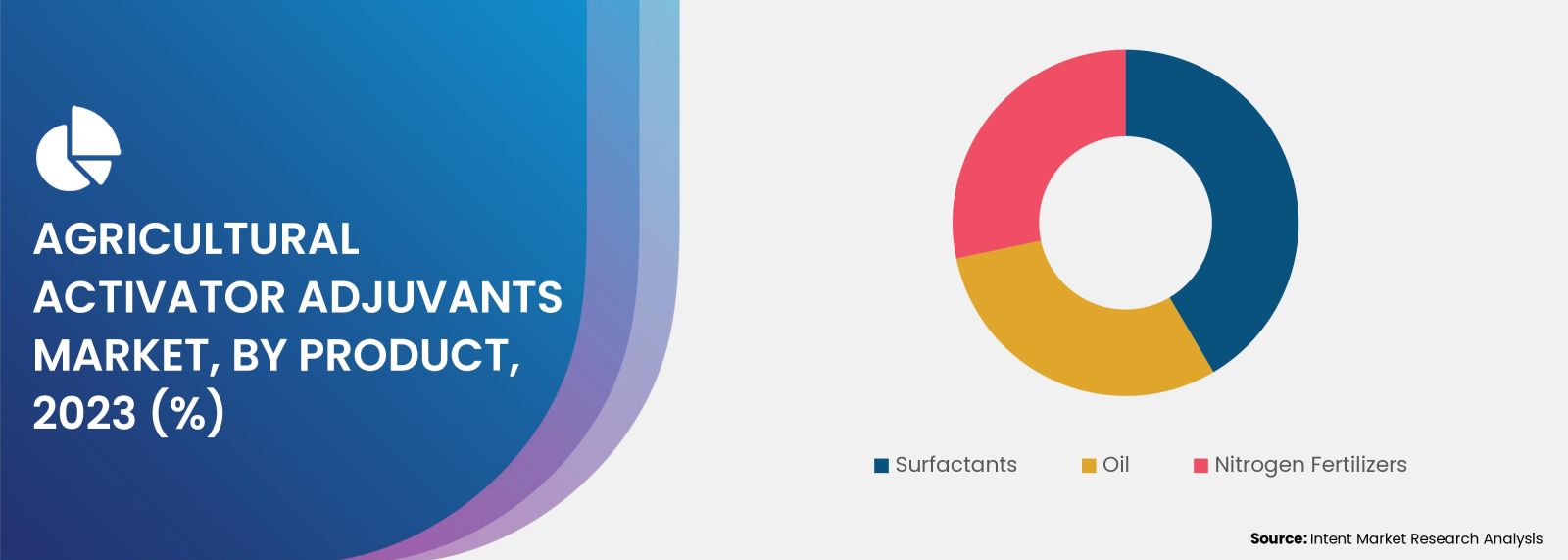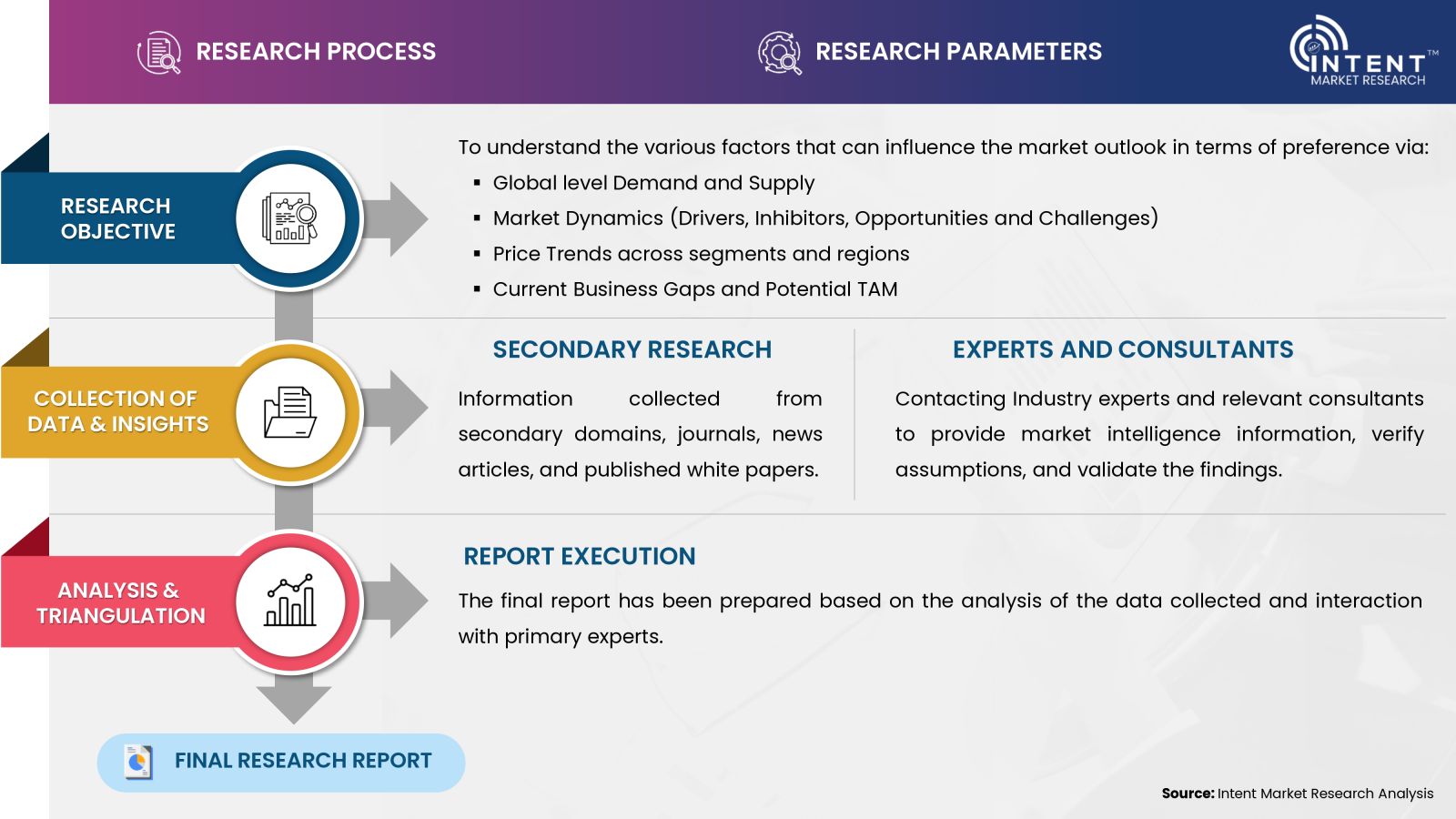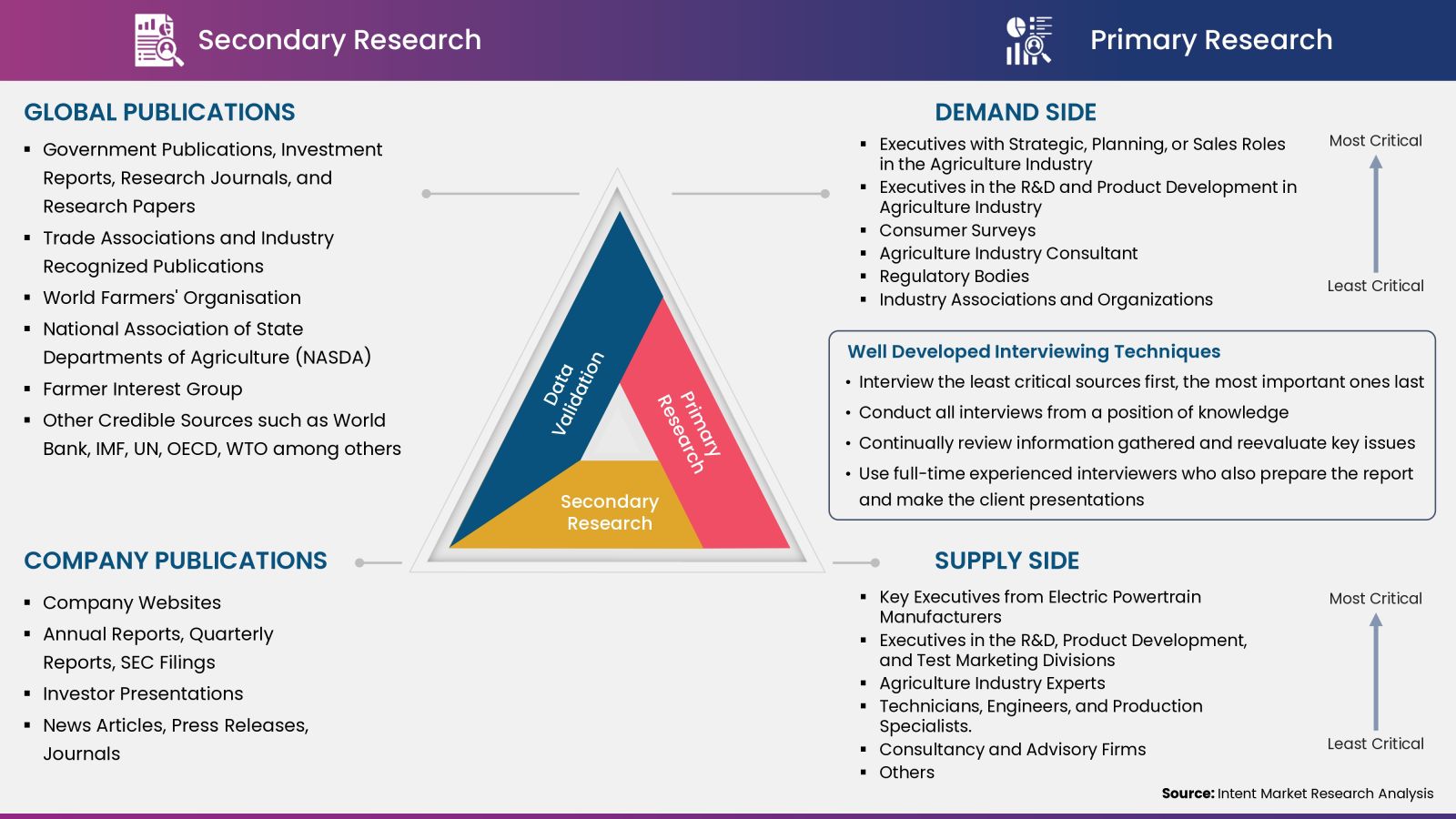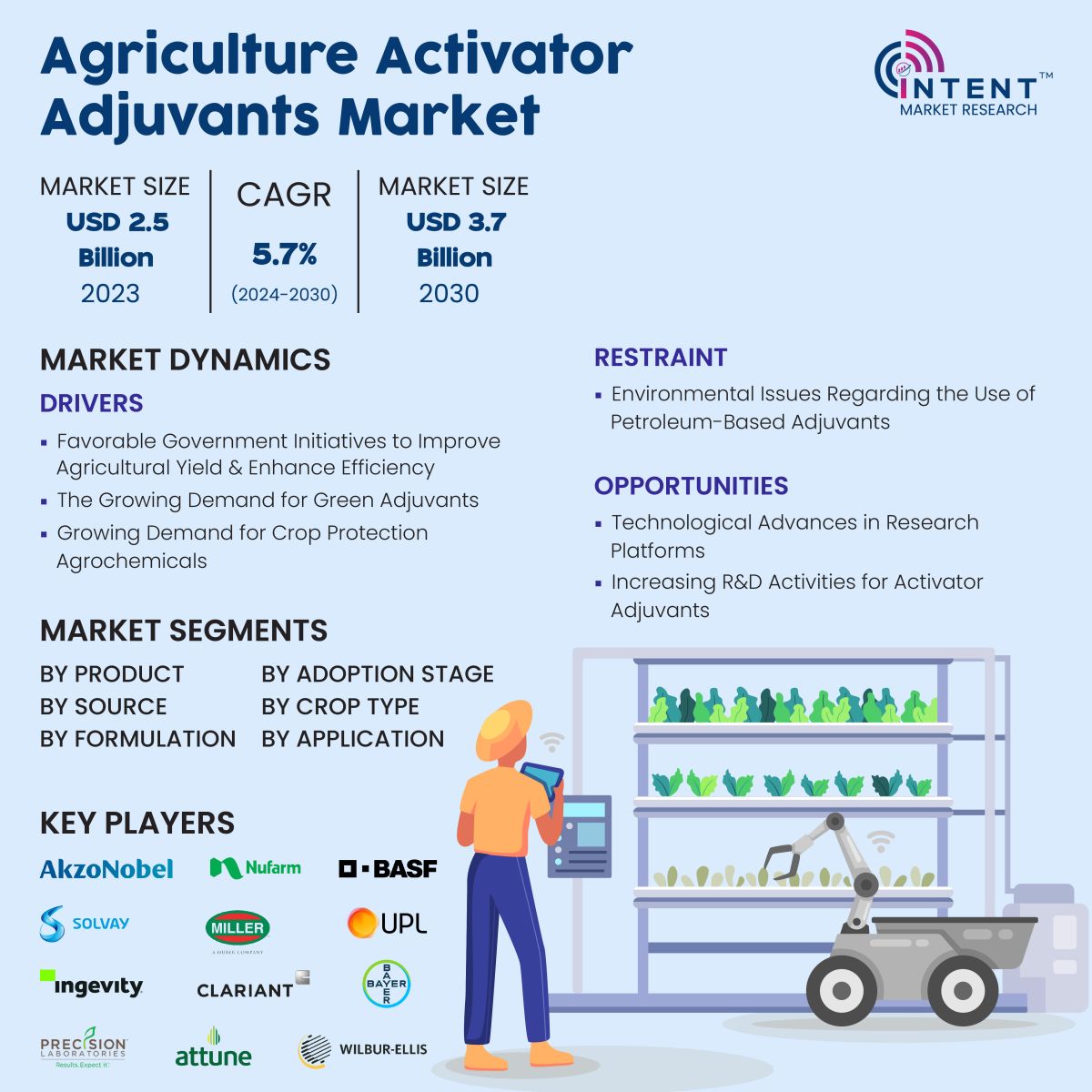As per Intent Market Research, the Agricultural Activator Adjuvants Market was valued at USD 2.5 billion in 2023-e and will surpass USD 3.7 billion by 2030; growing at a CAGR of 5.7% during 2024 - 2030.

The agricultural activator adjuvants market is expected to grow significantly over the forecast period due to their positive effect on crop production and reduced wastage of agrochemicals in farming. An adjuvant is an additional material that is added to an agrochemical spray mixture to improve the desired chemical's performance and physical characteristics.
Agriculture activator adjuvants are made to do specific tasks, such as dispersing, emulsifying, spreading, sticking, and wetting that are associated with the mixing and application of pesticides. Additionally, they can lessen volatilization, foaming, spray drift, and evaporation. Adjuvants of different types can be combined to perform multiple functions such as improving pesticide efficacy while lowering application issues.
Agriculture Activator Adjuvants Market Dynamics
Favorable Government Initiatives to Improve Agricultural Yield and Enhance Efficiency Will Drive the Market
The agricultural activator adjuvants market is experiencing significant growth driven by its increasing government support towards the benefit of farmers and agriculture. Many governments have expanded the scope of their policies to achieve other goals, such as supporting more inventive and competitive industries and environmentally sustainable production systems that are more resilient to risks such as climate change.
The Growing Demand for Green Adjuvants is Creating Market Growth Opportunities
The expansion of this sector is a result of the growing preference for environmentally friendly adjuvants, driven by heightened consumer focus on their health and well-being. Foods produced organically are becoming more and more popular among consumers. As a result, businesses are concentrating on creating bio-based and environmentally friendly adjuvants such as methylated seed oil, organo-modified siloxanes, and modified vegetable oils.
For instance, in November 2023, BASF and Yunnan entered into a collaboration to launch climate-smart farming project to reduce the CO2 emission during the use of pesticides. The project findings encourage climate-smart farming projects in China and provide room for program expansion internationally to enhance crop productivity across the globe while reducing harmful gases.
Environmental Issues Regarding the Use of Petroleum-Based Adjuvants May Hinder the Market Growth
Environmental issues regarding the use of petroleum-based agriculture adjuvants may inhibit market growth due to the emission of harmful gas and the release of toxic chemicals into the air. Many government and regulatory agencies are imposing strict regulations towards the use of toxic agricultural adjuvants. Petroleum-based adjuvants pose environmental risks, including non-biodegradability, toxicity, air and soil pollution, and climate change contribution. Their persistence in the environment emphasizes the need for eco-friendly alternatives derived from renewable sources to mitigate these concerns.
Agriculture Activator Adjuvants Market Segment Insights
The Surfactants Segment Holds a Prominent Market Share
The market is expected to be fueled by the diverse advantageous characteristics inherent in these agricultural activator adjuvants. These adjuvants are designed to perform tasks such as emulsification, sticking, spreading, dispersing, and wetting in the mixing and application of pesticides. Additionally, they have the capability to reduce issues like foaming, spray drift, evaporation, and volatilization.
Anionic surfactants are used for decreasing surface tension. They can enhance the pesticide's ability to emulsify, disperse, spread, and stick by allowing droplets to stay in contact with the leaf surface for extended periods. More pesticides can be absorbed by the leaf by lengthening the time a droplet is able to remain on the leaf surface. The environment, plant characteristics, and
interactions between the surfactant, pesticide, and carrier all affect overall effectiveness.

Agriculture Activator Adjuvants Market is Anticipated to Witness Growth Primarily Driven By the Suspension Form Segment
Suspension form adjuvants in agriculture improve leaf penetration, lower surface tension, and enable effective pesticide penetration into plant structures. This contrasts with other formulations like emulsifiable concentrate and wettable powder. Suspensions have become popular due to their advantages, including the absence of dust, user-friendly application, and high efficacy. It offers advantages such as water-solubility, is free from inflammable materials, and is employed for pesticides having small particle sizes consisting of solid ingredients dispersed in water components.
Natural Segment Held the Largest Share in the Agricultural Activator Adjuvants Market
Various types of bio-based activator adjuvants are used to enhance better ingredient uptake to improve overall efficiency. Natural activator adjuvants offer promising sustainability and generate opportunities for both consumers and businesses. Bio-based products are not only beneficial for the environment but also economically viable. Bio-based goods have consequently grown to be a desirable option due to their low impact on environmental pollution and reduced emissions of greenhouse gas.
Tank-Mix Segment Is Expected to Be Fastest Growing Market Share
Tank-mix adjuvants are expected to be fastest growing segment owing to their various advantages to enhance performance of agrochemicals. They are utilized to augment the efficacy of the spray solution by enhancing its spreading, penetration, or droplet size. Additionally, these adjuvants aid in alleviating potential application issues, ultimately boosting the overall effectiveness of the spray solution. Major market players are developing and launching products that are incorporated into a spray tank mixture to enhance the effectiveness of fungicides. In May 2023, BASF, a Germany-based chemical company launched Agnique HP 450 that enhances fungicide effectiveness and boosts productivity. The new adjuvant, derived from plants and biodegradable, is designed to enhance crop protection product application efficiency, leading to increased production.
Cereals and Grains Is Accounted for Largest Market Share
Cereal and grain crops, commonly grown in monoculture systems, are particularly vulnerable to pests and diseases, making adjuvants essential for optimizing pest management strategies. Activator adjuvants play a crucial role in agriculture by aiding farmers in reducing pesticide usage without compromising pest control effectiveness. These adjuvants enhance the efficacy of crop protection products by improving wetting and spreading. Adjuvants also increase penetration of pesticides, ensuring comprehensive coverage on cereal and grain surfaces. this results in more efficient control of pests and weeds. The use of adjuvants allows for lower pesticide application rates, contributing to the reduction of environmental impact associated with farming practices.
Widespread Use of Herbicides in Crop Production Across the Globe to Boost the Market Growth
The rising use of herbicides is attributed to extensive use of products such as glyphosate and glufosinate to increase the crop production. Herbicides that are selective in nature effectively eliminate specific weeds in a designated area without causing damage to the cultivated crops. These herbicides impede weed growth through diverse mechanisms. The increase in product demand for a variety of crops, including cotton, rice, fruits, and vegetables, is the reason for this growth.
North America is Poised for Significant Market Growth over the Forecast Period
North America held the largest market share in the overall agricultural activator adjuvants market. The regional growth can be attributed to the ongoing decline in the arable land area and rising consumer demand for food of consistent growth. Rapidly rising population and a rise in the need for food is a major driving factor. Adoption of precision agriculture, farming technologies, growing awareness of the effects of agriculture on the environment, and a rise in interest in sustainable production systems are the primary factors contributing to the regional market growth.
Major Industry Players Are Focusing on Research and Innovation to Strengthen their Position in the Market
The market is characterized by intense competition due to the presence of numerous international and domestic players. The agricultural activator adjuvants market is dominated by key players such as Akzo Nobel, Attune Agriculture, BASF, Bayer, Clariant, Ingevity, Miller Chemical, Nufarm, Precision Laboratories, Solvay, UPL, Wilbur-Ellis, and WinField. These industry leaders are primarily focused on innovating their product lines to sustain their position in the global market.
- In May 2023, BASF, a Germany-based chemical company, launched two novel herbicides, Facet and Duvelon, aimed at assisting rice and tea farmers in India in protecting their crops from intrusive weeds. Facet is specifically designed for use in rice fields, while Duvelon is optimized for application in tea plantations. These innovative solutions provide Indian farmers with a dependable tool for effective weed management.
Agriculture Activator Adjuvants Market Coverage
The report provides key insights into the agricultural activator adjuvants market, and it focuses on technological developments, trends, and initiatives taken by the government in this sector. The report delves into market drivers, restraints, and opportunities, and analyzes key players as well as the competitive landscape within the market. The report offers the market size and forecasts for the agricultural activator adjuvants market in value (USD billion) for all the above segments.

Report Scope
|
Report Features |
Description |
|
Market Size (2023-e) |
USD 2.5 billion |
|
Forecast Revenue (2030) |
USD 3.7 billion |
|
CAGR (2024-2030) |
5.7% |
|
Base Year for Estimation |
2023-e |
|
Historic Year |
2022 |
|
Forecast Period |
2024-2030 |
|
Report Coverage |
Market Forecast, Market Dynamics, Competitive Landscape, Recent Developments |
|
Segments Covered |
Agricultural Activator Adjuvants Market By Product (Surfactants, Oil, Nitrogen Fertilizers), By Source (Natural, Synthetic), By Formulation (Suspension-form, Emulsion-form), By Adoption Stage (In-Formulation, Tank-Mix), By Crop Type (Cereals and Grains, Oilseeds and Pulses, Fruits and Vegetables, Others), By Application (Herbicides, Insecticides, Fungicides) |
|
Regional Analysis |
North America (US, Canada), Europe (Germany, France, UK, Spain, Italy), Asia-Pacific (China, Japan, South Korea, India), Latin America (Brazil, Mexico, Argentina), Middle East and Africa (Saudi Arabia, South Africa, Turkey, United Arab Emirates) |
|
Competitive Landscape |
Akzo Nobel, Attune Agriculture, BASF, Bayer, Clariant, Ingevity, Miller Chemical, Nufarm, Precision Laboratories, Solvay, UPL, Wilbur-Ellis and WinField. |
|
Customization Scope |
Customization for segments, region/country-level will be provided. Moreover, additional customization can be done based on the requirements. |
|
Purchase Options |
We have three licenses to opt for Single User License, Multi-User License (Up to 5 Users), Corporate Use License (Unlimited User and Printable PDF) |
|
1.Introduction |
|
1.1. Study Assumptions and Market Definition |
|
1.2. Scope of the Study |
|
2.Research Methodology |
|
3.Executive Summary |
|
4.Market Dynamics |
|
4.1. Market Growth Drivers |
|
4.1.1. Favourable Government Initiatives to Improve Agricultural Yield and Enhance Efficiency |
|
4.1.2.The Growing Demand for Green Adjuvants |
|
4.1.3. Growing Demand for Crop Protection Agrochemicals |
|
4.2. Market Growth Restraints |
|
4.2.1.Environmental Issues Regarding the Use of Petroleum-Based Adjuvants |
|
4.3. Market Growth Opportunities |
|
4.3.1. Technological Advances in Research Platforms 4.3.2. Increasing R&D activities for activator adjuvants |
|
5.Market Outlook |
|
5.1. Supply Chain Analysis |
|
5.2. Technology Trends |
|
5.3. Patent Analysis |
|
6.Market Segment Outlook (Market Size & Forecast: USD Billion, 2024 – 2030) |
|
6.1. Segment Synopsis |
|
6.2. By Product |
|
6.2.1. Surfactants |
|
6.2.2. Oil-Based |
|
6.2.3. Nitrogen Fertilizers |
|
6.3. By Source |
|
6.3.1. Natural |
|
6.3.2. Synthetic 6.4. By Formulation 6.4.1. Suspension-form 6.4.1. Emulsion-form 6.5 By Adoption Stage 6.5.1. In-Formulation 6.5.2. Tank-Mix |
|
6.6. By Crop Type |
|
6.4.1. Cereals and Grains |
|
6.4.2. Oilseeds and Pulses |
|
6.4.3. Fruits and Vegetables |
|
6.7. By Application |
|
6.5.1. Herbicides |
|
6.5.2. Insecticides |
|
6.5.3. Fungicides |
|
7.Regional Outlook (Market Size & Forecast: USD Billion, 2024 – 2030) |
|
7.1. Global Market Synopsis |
|
7.2. North America |
|
7.2.1. North America Agricultural activator adjuvants Market Outlook |
|
7.2.2. USA |
|
7.2.2.1.USA Agricultural Activator Adjuvants Market, By Product |
|
7.2.2.2.USA Agricultural Activator Adjuvants Market, By Source 7.2.2.2.USA Agricultural Activator Adjuvants Market, By Formulation 7.2.2.2.USA Agricultural Activator Adjuvants Market, By Adoption Stage |
|
7.2.2.3.USA Agricultural Activator Adjuvants Market, By Crop Type |
|
7.2.2.4.USA Agricultural Activator Adjuvants Market, By Application |
|
*Note: Cross-segmentation by segments for each country will be covered as shown above. |
|
7.2.3. Canada |
|
7.2.4. Mexico |
|
7.3. Europe |
|
7.3.1. Europe Agricultural Activator Adjuvants Market Outlook |
|
7.3.2. Germany |
|
7.3.3. UK |
|
7.3.4. France |
|
7.3.5. Spain |
|
7.3.6. Italy |
|
7.4. Asia-Pacific |
|
7.4.1. Asia-Pacific Agricultural Activator Adjuvants Market Outlook |
|
7.4.2. China |
|
7.4.3. India |
|
7.4.4. Japan |
|
7.4.5. South Korea |
|
7.4.6. Australia |
|
7.5. Latin America |
|
7.5.1. Latin America Agricultural Activator Adjuvants Market Outlook |
|
7.5.2. Brazil |
|
7.5.3. Argentina |
|
7.6. Middle East & Africa |
|
7.6.1. Middle East & Africa Agricultural Activator Adjuvants Market Outlook |
|
7.6.2. Saudi Arabia |
|
7.6.3. UAE |
|
8.Competitive Landscape |
|
8.1. Market Share Analysis |
|
8.2. Company Strategy Analysis |
|
8.3. Competitive Matrix |
|
9.Company Profiles |
|
9.1. Akzo Nobel |
|
9.1.1.Company Synopsis |
|
9.1.2.Company Financials |
|
9.1.3.Product/Service Portfolio |
|
9.1.4.Recent Developments |
|
*Note: All the companies in the section 9.1 will cover same sub-chapters as above. |
|
9.2.Attune Agriculture |
|
9.3. BASF |
|
9.4. Bayer |
|
9.5. Clariant |
|
9.6. Helena |
|
9.7. Ingevity |
|
9.8. Miller Chemical |
|
9.9. Nufarm |
|
9.10.Precision Laboratories |
|
9.11.Solvay |
|
9.12.Stepan |
|
9.13.UPL |
|
9.14.WinField |
Intent Market Research employs a rigorous methodology to minimize residual errors by carefully defining the scope, validating findings through primary research, and consistently updating our in-house database. This dynamic approach allows us to capture ongoing market fluctuations and adapt to evolving market uncertainties.
The research factors used in our methodology vary depending on the specific market being analyzed. To begin with, we incorporate both demand and supply side information into our model to identify and address market gaps. Additionally, we also employ approaches such as Macro-Indicator Analysis, Factor Analysis, Value Chain-Based Sizing, and forecasting to further increase the accuracy of the numbers and validate the findings.
Research Approach

- Secondary Research Approach: During the initial phase of the research process, we acquire and accumulate extensive data continuously. This data is carefully filtered and validated through a variety of secondary sources.
- Primary Research Approach: Following the consolidation of data gathered through secondary research, we initiate a validation and verification process to verify all the market numbers and assumptions by engaging with the subject matter experts.
Data Collection, Analysis and Interpretation:

Research Methodology
Our market research methodology utilizes both top-down and bottom-up approaches to segment and estimate quantitative aspects of the market. We also employ multi-perspective analysis, examining the market from distinct viewpoints.


